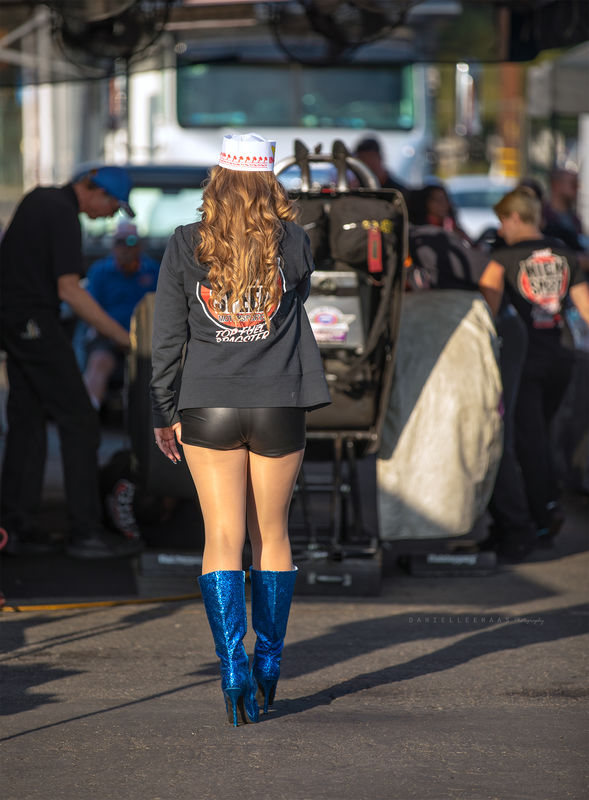Circular Polarizer Reduces Image Quality?
Jan 29, 2019 12:58:30 #
dandev wrote:
Full res JPRGS. Shot at 200mm.
About the only difference I see is that the CP lost you one stop of light indicated by the shutter speed being half what it was in the non CP shot. They seem to be about the same sharpness to me.
Jan 29, 2019 13:37:25 #
jeep_daddy wrote:
About the only difference I see is that the CP lost you one stop of light indicated by the shutter speed being half what it was in the non CP shot. They seem to be about the same sharpness to me.
CP loss should be minimum 1.5 stops....
Jan 29, 2019 14:02:36 #
amfoto1
Loc: San Jose, Calif. USA
Haydon wrote:
The second image was shot at 1/80 of a second. The one above it was shot at 1/160....
Bingo! This is probably what you are seeing in the soft images. The light lost to the CPL filter is causing a slower shutter speed to be used. And either camera movement or subject movement... or a little of each... is causing some "softness" in the CPL images. Some slower shutter speeds are even susceptible to internal camera vibration from the mirror and/or shutter.
Hoya HD filters are pretty high quality. That being the case, all other things being equal I doubt you'd see much diff from the filter alone unless you look very, very closely.
However, ANY filter costs a little bit of resolution. That's inevitable whenever light has to cross additional air/glass boundaries... And it's more with a CPL because it uses multiple layers of glass and a polarizing "foil" sandwiched between them. Very high quality, multi-coated filters minimize this loss to the point it's usually not noticeable... but there's always some (compare the file sizes of two shots of the same subject... identical except one with a filter, the other without.... the filter shot file will always be a little smaller).
I disagree with an earlier suggestion that UV filters reduce reflections. They don't. (CPL reduce reflections.) On rare occasion a UV might slightly reduce a bluish haze in a scene... but they basically do nothing to improve a digital image and serve no purpose (okay... "protection" for some... as much as some thin piece of glass might be expected to give).
NO filter EVER "sharpens" an image. Under some lighting conditions it might increase contrast, which give the impression of greater sharpness (but the same can be done in post-processing).
In fact, in some challenging lighting conditions a filter... ANY filter... and especially multi-layer filters like CPL... will increase overall veiling flare that reduces contrast and color saturation and add ghost flare artifacts or even "halos" around strong light sources and amplified chromatic aberration. Much of this is from the light "bouncing" back and forth between lens elements and the surfaces of the filter. Once again, multi-coatings can help minimize it, but they usually don't completely eliminate the flare caused by a filter. \
I am pretty sure it was "tongue in cheek", but I also disagree with...
Quote:
As you know from other posts here that any filter destroys IQ especially if it is clear.
Again from the many posts in this forum you should never put anything in front of your lens due to horrific image degradation.
So your only option according to the many posts here of a decent photo is to never ever use a filter of any kind on your lens. If you do according to numerous posts here your pictures will always suck and be worthless.
Again from the many posts in this forum you should never put anything in front of your lens due to horrific image degradation.
So your only option according to the many posts here of a decent photo is to never ever use a filter of any kind on your lens. If you do according to numerous posts here your pictures will always suck and be worthless.
Like almost everything related to photography, it's all about weighing various pluses and minuses to find the right compromise for any given situation. There are times and places where the benefits of a filter easily out-weigh the negatives of using one. The "trick" is making the right choice at the right time. The "problem" is that people are lazy or forgetful.... Such as over-using filters needlessly. Most of the time "protection" isn't needed. But sometimes it is. There are also people who never use a lens hood, can't be bothered with them. Sure, sometimes you can't use a hood. But one makes sense to use most of the time, can actually provide better protection than some thin piece of glass ever could, and might even be needed to "protect" a filter!
And I can't agree that a CPL should never be used for portraiture. There are people who have "shiny" skin. Not necessarily "oily", just reflective and shiny. Eyeglasses are also another time that a CPL might be helpful.
But it doesn't always work... eyeglasses can be a real pain!
An old school "fix" was to temporarily remove the lenses from them and take the shots with just the frames. (Easily done with some eyeglasses... but not with others.)
It also might have helped to polarize your light sources. There are sheets of polarizing materials available for this purpose. (This can be standard polarization... not circular.)
Some years ago I shot a friend's party that was being held at a restaurant. Had to use flash due to the lighting conditions and capabilities of the cameras I was using at the time. One fun shot of a couple cute young ladies looked to be spoiled by a strong reflection from the lens of the eyeglasses one of them was wearing. Her right eye was almost completely obscured by the reflection. However, in Photoshop I was able to make a copy of her other eye, "flop" it and use that to carefully replace the lens with the strong reflection. I didn't have much experience doing this or much hope for success... but a little careful blending and it looked quite good. Enough for a moderate size print. The rest of the image was great, so it was worth the effort to save it (and really wasn't that hard to do).
Jan 29, 2019 16:12:52 #
catchlight..
Loc: Wisconsin USA- Halden Norway
Polarize filter ...
I try to get it as sharp as possible ... The speed shot is panned and sharp at 1/200th.
I posted earlier that there is no difference in sharpness, but glare and flare from a UV filter can be an issue... I hope you reconsider the "horiffic image degrigation" quote... that's so not true
(I am a professional photojournalist)
I try to get it as sharp as possible ... The speed shot is panned and sharp at 1/200th.
I posted earlier that there is no difference in sharpness, but glare and flare from a UV filter can be an issue... I hope you reconsider the "horiffic image degrigation" quote... that's so not true
(I am a professional photojournalist)
Architect1776 wrote:
As you know from other posts here that any filter destroys IQ especially if it is clear.
Again from the many posts in this forum you should never put anything in front of your lens due to horrific image degradation.
So your only option according to the many posts here of a decent photo is to never ever use a filter of any kind on your lens. If you do according to numerous posts here your pictures will always suck and be worthless.
Again from the many posts in this forum you should never put anything in front of your lens due to horrific image degradation.
So your only option according to the many posts here of a decent photo is to never ever use a filter of any kind on your lens. If you do according to numerous posts here your pictures will always suck and be worthless.
Jan 29, 2019 17:54:38 #
amfoto1 wrote:
Like almost everything related to photography, it'... (show quote)
It was not tongue in cheek. It is so true if you look up UV filters for protection here and see the scathing negative remarks regarding the filters.
Jan 29, 2019 18:21:52 #
dandev wrote:
I did a headshot photoshoot last week and thought ... (show quote)
All filters produce a softer image when using a 400mm or higher lens in my experience since I have done a lot of testing the last few years.
Jan 29, 2019 18:56:15 #
Regis wrote:
All filters produce a softer image when using a 400mm or higher lens in my experience since I have done a lot of testing the last few years.
Yes, longer focal length lenses exacerbate the possibility of lower optical performance with filters .
..
Jan 29, 2019 19:02:18 #
catchlight..
Loc: Wisconsin USA- Halden Norway
When shooting with long lenses like a 400, atmosphere plays a bigger role...
For arguments sake it would be good to post definitive testing data when posting a strong opinion.
I don't use UV's, I feel they are a waste of money but, they do not effect sharpness.
https://www.youtube.com/watch?time_continue=149&v=P0CLPTd6Bds
For arguments sake it would be good to post definitive testing data when posting a strong opinion.
I don't use UV's, I feel they are a waste of money but, they do not effect sharpness.
https://www.youtube.com/watch?time_continue=149&v=P0CLPTd6Bds
Regis wrote:
All filters produce a softer image when using a 400mm or higher lens in my experience since I have done a lot of testing the last few years.
Jan 29, 2019 19:17:17 #
catchlight..
Loc: Wisconsin USA- Halden Norway
Canon uses rear load filters at all times and the front glass is not the lens on the long L glass. My 200 f/2.0L IS, 300 f/2.8 IS and 400 f/2.8L IS all use a rear insert gel filter...
If filters degrade the sharpness then, I am sure Canon or someone wise would tell you to remove the factory filter system.
They are all incredibly sharp lenses wide open with or without the polarize filter. Things may be arguably different if you are shooting cheaper grade lenses but, that I would have to see with testing data.
I see no difference with the rear polarize filter used when comparing sharpness on any of the lenses.
If filters degrade the sharpness then, I am sure Canon or someone wise would tell you to remove the factory filter system.
They are all incredibly sharp lenses wide open with or without the polarize filter. Things may be arguably different if you are shooting cheaper grade lenses but, that I would have to see with testing data.
I see no difference with the rear polarize filter used when comparing sharpness on any of the lenses.
Regis wrote:
All filters produce a softer image when using a 400mm or higher lens in my experience since I have done a lot of testing the last few years.
Jan 29, 2019 19:24:36 #
Bokehen wrote:
Typically the polarization filter is used for landscape shots, the Defuser is used to soften portrait shots and the UV is used to reduce glare during bright or sunny conditions. However, even if the filter was on the lens and was not tuned to it's ideal adjustment, there could be some distortion as indicated with your comments.
A defuser renders bombs inoperable.
Perhaps diffuser is the word you are looking for?
Jan 29, 2019 20:07:18 #
Dikdik
Loc: Winnipeg, Canada
Because of what colour filters do and the way they work, you would think that this would be built into the software. Polarisers and that type of filter would not be software 'workable'.
Dik
Dik
Jan 29, 2019 21:56:40 #
catchlight.. wrote:
When shooting with long lenses like a 400, atmosphere plays a bigger role...
For arguments sake it would be good to post definitive testing data when posting a strong opinion.
I don't use UV's, I feel they are a waste of money but, they do not effect sharpness.
https://www.youtube.com/watch?time_continue=149&v=P0CLPTd6Bds
For arguments sake it would be good to post definitive testing data when posting a strong opinion.
I don't use UV's, I feel they are a waste of money but, they do not effect sharpness.
https://www.youtube.com/watch?time_continue=149&v=P0CLPTd6Bds
All I can tell you is theoretically they impact lens performance - this is physics. As a practical matter, in YOUR work are YOU able to discern this performance shift ?? - maybe, maybe not depending on how astute you are and how close you look !
Most protective front (and rear) filters made by the lens maker are engineered as an intregal part of the optical formula with great care (and cost). That is what differentiates them from third party add-ons.
..
Jan 29, 2019 22:10:20 #
catchlight.. wrote:
For arguments sake it would be good to post definitive testing data when posting a strong opinion
https://www.youtube.com/watch?time_continue=149&v=P0CLPTd6Bds
For arguments sake it would be good to post definitive testing data when posting a strong opinion
https://www.youtube.com/watch?time_continue=149&v=P0CLPTd6Bds
Yes, it would be good - but for old highly experienced people like me it may not be possible always - in which case you will have to rely on my credibility from experience, look at my work, past postings and draw your own conclusions. I have read the books, seen the diagrams - but my memory cannot tell you exactly where. I am sure it is on the internet somewhere - but I do not know where and I am not going to look for it so you will have to take my word for it - if you please - or not.
..
Jan 30, 2019 05:30:56 #
Jan 30, 2019 05:57:36 #
I would like to see the portrait. That way I could give better critique. I don't think it was the Circular Polarizing filter. It may have been your lighting. Did you use a flash and what was its setting? When people wear glasses, I try to have them look off to the side or have them take off the glasses off altogether.
If you want to reply, then register here. Registration is free and your account is created instantly, so you can post right away.











